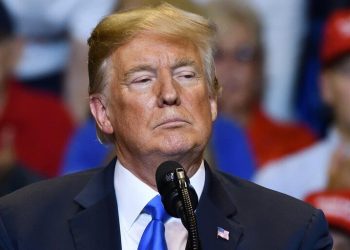My local bookstore has been taking advantage of me for years. I have run a trade deficit, giving it money with nothing but books in return. At the same time I have been taking advantage of my employer, running a trade surplus with it as it gives me a salary with nothing but educational services in exchange.
Thinking that way about the kinds of exchanges we all engage in is obviously absurd. But that’s precisely the reasoning behind the “reciprocal tariffs” President Trump is expected to announce this week. The details have not yet come into view, but if he does follow through, it’s clear the plan would add to what are already the nation’s highest tariffs since the 1940s. Their effect will be lower economic growth, higher inflation, higher unemployment, the destruction of wealth and a tax increase on American families. It will deal a blow to the rules underlying the global trading system and further empower China.
Mr. Trump has cycled through numerous rationales for tariffs: They will raise revenues, with foreigners footing the bill. They will help American manufacturers and national security. They will provide leverage against Mexican fentanyl and Canadian sovereignty. In all of these cases there is a bit of truth and a lot of falsehood.
But the one argument Mr. Trump has returned to again and again is that other countries are taking advantage of the United States. He measures the degree to which they are doing so by the magnitude of our trade deficit with them — that is, how much more money we spend on another country’s goods and services than we get from selling it our goods and services.
In this reckoning, the reason those deficits arise is that other countries erect tariffs and other trade barriers against the United States. It follows from this analysis that the solution is to reciprocate by erecting our own tariffs, which will either protect the United States or else get other countries to lower their barriers, either way reducing or eliminating the trade deficits.
Every step in this chain of reasoning is wrong.
Start with the fact that imports are good, not bad. They offer consumers greater variety, such as avocados from Mexico, lower prices on cars from South Korea or greater quality, including Champagne from France. American companies are able to offer better products at lower prices and be globally competitive because they use imported steel, auto parts and precision machinery. Moreover, importing these items frees us up to devote more of our production and employment to higher productivity and higher-wage jobs, including in export industries such as aerospace and software design.
Running bilateral trade deficits is generally not an indication of a problem or an abuse. In recent years the United States exported more to Brazil than it imported, a fact that had more to do with Brazil’s appetite for American oil and airplanes than any trade barriers. In fact, Brazil levies an average tariff of 6 percent on goods coming from the United States, well in excess of the 1 percent levied by the United States on imports from Brazil. Same in reverse for the United States and France: We import more than we export despite having a higher tariff on their goods than they do on ours.
In fact, there is generally no correlation between a country’s tariff levels and its overall trade balance. A particularly clear example is the 27 countries in the European Union, which have identical tariffs and other trade policies but range from trade deficits to trade surpluses.
So if tariffs don’t create trade deficits, what does? The answer has to do with whether a country saves its money or invests it, in things like factories, infrastructure and research. The United States invests more than it saves, which has helped fuel our enviable productivity and growth. To fill the gap, we attract money from overseas. Foreign investors exchange their euros, yen and yuan for dollars to invest in the United States. We can then use those euros, yen and yuan to buy more of what we want from Europe, Japan and China than we sell them. Voilà, a deficit.
What then will these reciprocal tariffs do? They will lessen the overall volume of trade. The United States will import less because foreign goods and services will become more expensive. It will also export less, because the tariffs that other countries erect against us will make our stuff more expensive for them.
If other countries don’t retaliate against our tariffs with a slew of their own, a different set of problems arises. Take automobile tariffs on Mexico. They would cause Americans to buy fewer cars from that country, so we would need fewer pesos, the things with which you buy their cars. As demand for Mexican currency goes down, so does its value relative to the dollar. But a strong dollar makes it more expensive for foreign countries to buy our exports. Either way, less trade, which would be bad for both consumers and workers. (As an aside, if the tariffs do succeed in meaningfully lowering trade deficits it would most likely be because they caused a recession, bringing down the amount U.S. consumers buy or businesses invest.)
If all reciprocal tariffs are bad in theory, however, Mr. Trump’s seem likely to be even worse in practice. That’s because he’s not just looking to even things out with other countries by raising U.S. tariffs by a percentage point or two, the current difference in tariff rates between the United States and many of its trade partners. Instead, he has been cherry-picking examples of goods where other countries have higher tariffs than the United States while ignoring the many cases where the reverse is true.
The president even claimed that foreign value-added taxes, or VATs, discriminate against American exports. It is true that these VATs apply to American goods, from oranges to cars to cosmetics. But they apply in equal measure to European oranges and cars and cosmetics. They don’t discriminate against the United States or any other country. And demanding that European countries change them would mean demanding that they alter core aspects of their tax systems. Why would they ever agree?
The consequences of this are serious. In Mr. Trump’s first term he raised average tariffs by about 1.5 percentage points. With all of the trade measures he has already carried out this year, they have gone up another six percentage points — and reciprocal tariffs could add much more. All told, the tariff increases in the first four months of his latest trade war are likely to be five to 10 times as large as those he imposed in the four years of his first term.
There’s been a lot of talk about whether that will crash the economy altogether. The enormous increase in business uncertainty that tariffs have engendered means anything could happen. Goldman Sachs, however, estimates that given this new round of tariffs, economic growth will decline by about 0.5 percentage point (largely because imported goods are only one-tenth of U.S. gross domestic product). Not a huge number on its own, though it translates to about $1,000 per household but it would push up inflation by a similar magnitude. All of this is on top of the harm done by all the tariffs that have already been announced.
Lower-income families will pay a higher fraction of their income in tariffs, but the revenue will very likely go to tax cuts skewed to high-income households. The stock market has already lost more than $3 trillion since Mr. Trump first dialed up his tariff threats in February. The losses could grow over time as the United States increasingly distances itself from the benefits of imports, exports and global supply chains.
The geopolitical realignment this will help engender may be even more profound. The United States has leverage vis-à-vis Canada and Mexico because we are their main trade partner. But China is the largest trading partner for a majority of countries in the world. Give these countries a choice between economic relations with the United States and with China, they would probably choose the latter in a heartbeat. And where economic relations go, political relations will follow. This week’s tariffs are another step toward hurting the U.S. economy and creating a geopolitical system that increasingly has China at its center.
Jason Furman, a contributing Opinion writer, is a professor of the practice of economic policy at Harvard University and was chairman of the White House Council of Economic Advisers from 2013 to 2017.
Source images by ZargonDesign and Arthur Morris/Getty Images.
The Times is committed to publishing a diversity of letters to the editor. We’d like to hear what you think about this or any of our articles. Here are some tips. And here’s our email: letters@nytimes.com.
Follow the New York Times Opinion section on Facebook, Instagram, TikTok, Bluesky, WhatsApp and Threads.
#Opinion #Trumps #Tariffs #Absolutely #Sense





















